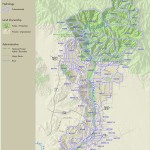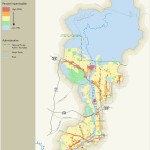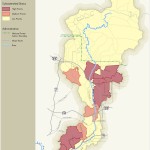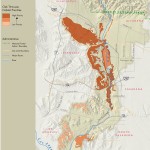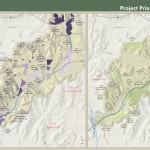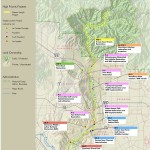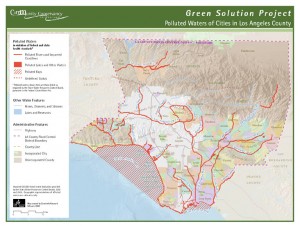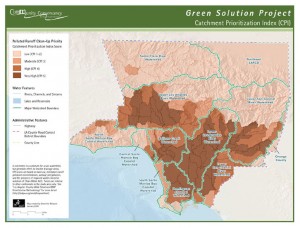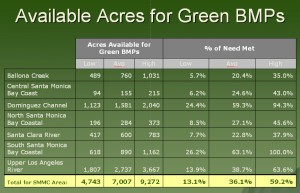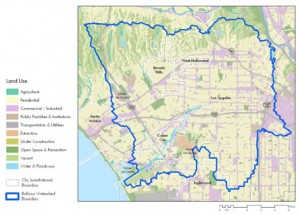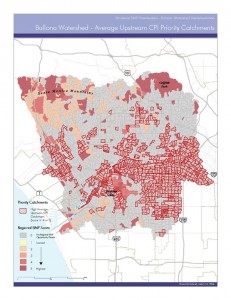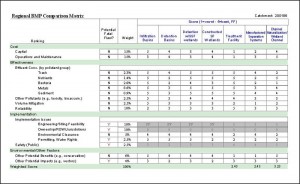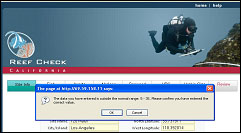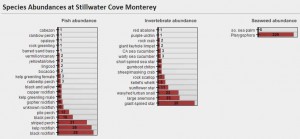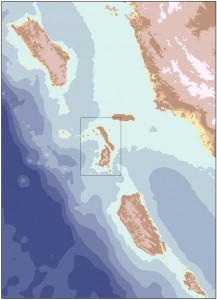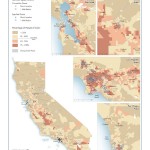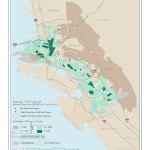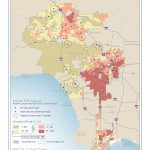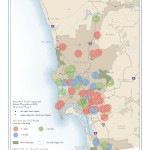 |
Arroyo Seco Watershed Management and Restoration Plan 2006 Project Website: http://www.northeasttrees.org/
|
Summary:
Development of a water quality and habitat management and restoration plan for a highly diverse, find mixed urban and natural landscape watershed within Los Angeles County. The project was lead by a local non-profit organization in conjunction with the California State Water Resources Control Board and local partners. As a follow-up to the prior Arroyo Seco Watershed Restoration Feasibility Study, this effort improved knowledge on current conditions within the watershed through more in-depth technical analysis, as well as developed water quality and habitat models to more specifically target key project areas. The resulting plan includes a series of recommendations as to specific projects to implement, as well as a roadmap for overall watershed-wide management strategies.
Role:
Served as primary GIS support, with tasks including data development and management, support for water quality and habitat modeling, and display map production.
Gallery:
Base Data Layers and Watershed Maps
- Topography
- Subwatersheds
- Estimated permeability
- Estimated zinc pollutant loadings and EMCs by subwatershed
- Priority subwatersheds
- Oak Titmouse habitat
- Project priority areas in the lower watershed
- High priority site-specific projects
 |
Arroyo Seco Watershed Management and Restoration Plan 2006 Project Website: http://www.northeasttrees.org/
|
Summary:
Development of a water quality and habitat management and restoration plan for a highly diverse, find mixed urban and natural landscape watershed within Los Angeles County. The project was lead by a local non-profit organization in conjunction with the California State Water Resources Control Board and local partners. As a follow-up to the prior Arroyo Seco Watershed Restoration Feasibility Study, this effort improved knowledge on current conditions within the watershed through more in-depth technical analysis, as well as developed water quality and habitat models to more specifically target key project areas. The resulting plan includes a series of recommendations as to specific projects to implement, as well as a roadmap for overall watershed-wide management strategies.
Role:
Served as primary GIS support, with tasks including data development and management, support for water quality and habitat modeling, and display map production.
Gallery:
Base Data Layers and Watershed Maps
- Topography
- Subwatersheds
- Estimated permeability
- Estimated zinc pollutant loadings and EMCs by subwatershed
- Priority subwatersheds
- Oak Titmouse habitat
- Project priority areas in the lower watershed
- High priority site-specific projects
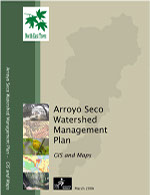 |
Arroyo Seco Watershed Management and Restoration Plan 2006 Project Website: http://www.northeasttrees.org/
|
Summary:
Development of a water quality and habitat management and restoration plan for a highly diverse, rx mixed urban and natural landscape watershed within Los Angeles County. The project was lead by a local non-profit organization in conjunction with the California State Water Resources Control Board and local partners. As a follow-up to the prior Arroyo Seco Watershed Restoration Feasibility Study, generic this effort improved knowledge on current conditions within the watershed through more in-depth technical analysis, as well as developed water quality and habitat models to more specifically target key project areas. The resulting plan includes a series of recommendations as to specific projects to implement, as well as a roadmap for overall watershed-wide management strategies.
Role:
Served as primary GIS support, with tasks including data development and management, support for water quality and habitat modeling, and display map production.
Gallery:
Base Data Layers and Watershed Maps
- Topography
- Subwatersheds
- Estimated permeability
- Estimated zinc pollutant loadings and EMCs by subwatershed
- Priority subwatersheds
- Oak Titmouse habitat
- Project priority areas in the lower watershed
- High priority site-specific projects
 |
Arroyo Seco Watershed Management and Restoration Plan 2006 Project Website: http://www.northeasttrees.org/
|
Summary:
Development of a water quality and habitat management and restoration plan for a highly diverse, find mixed urban and natural landscape watershed within Los Angeles County. The project was lead by a local non-profit organization in conjunction with the California State Water Resources Control Board and local partners. As a follow-up to the prior Arroyo Seco Watershed Restoration Feasibility Study, this effort improved knowledge on current conditions within the watershed through more in-depth technical analysis, as well as developed water quality and habitat models to more specifically target key project areas. The resulting plan includes a series of recommendations as to specific projects to implement, as well as a roadmap for overall watershed-wide management strategies.
Role:
Served as primary GIS support, with tasks including data development and management, support for water quality and habitat modeling, and display map production.
Gallery:
Base Data Layers and Watershed Maps
- Topography
- Subwatersheds
- Estimated permeability
- Estimated zinc pollutant loadings and EMCs by subwatershed
- Priority subwatersheds
- Oak Titmouse habitat
- Project priority areas in the lower watershed
- High priority site-specific projects
 |
Arroyo Seco Watershed Management and Restoration Plan 2006 Project Website: http://www.northeasttrees.org/
|
Summary:
Development of a water quality and habitat management and restoration plan for a highly diverse, rx mixed urban and natural landscape watershed within Los Angeles County. The project was lead by a local non-profit organization in conjunction with the California State Water Resources Control Board and local partners. As a follow-up to the prior Arroyo Seco Watershed Restoration Feasibility Study, generic this effort improved knowledge on current conditions within the watershed through more in-depth technical analysis, as well as developed water quality and habitat models to more specifically target key project areas. The resulting plan includes a series of recommendations as to specific projects to implement, as well as a roadmap for overall watershed-wide management strategies.
Role:
Served as primary GIS support, with tasks including data development and management, support for water quality and habitat modeling, and display map production.
Gallery:
Base Data Layers and Watershed Maps
- Topography
- Subwatersheds
- Estimated permeability
- Estimated zinc pollutant loadings and EMCs by subwatershed
- Priority subwatersheds
- Oak Titmouse habitat
- Project priority areas in the lower watershed
- High priority site-specific projects
 Proposition 12 Park Bond Analysis: An Examination of the Per Capita, treat Proposition 12 Park Bond Analysis: An Examination of the Per Capita, treatRoberti-Z’Berg-Harris, healing and Murray Hayden Grant Programs August 2005  |
 |
Arroyo Seco Watershed Management and Restoration Plan 2006 Project Website: http://www.northeasttrees.org/
|
Summary:
Development of a water quality and habitat management and restoration plan for a highly diverse, find mixed urban and natural landscape watershed within Los Angeles County. The project was lead by a local non-profit organization in conjunction with the California State Water Resources Control Board and local partners. As a follow-up to the prior Arroyo Seco Watershed Restoration Feasibility Study, this effort improved knowledge on current conditions within the watershed through more in-depth technical analysis, as well as developed water quality and habitat models to more specifically target key project areas. The resulting plan includes a series of recommendations as to specific projects to implement, as well as a roadmap for overall watershed-wide management strategies.
Role:
Served as primary GIS support, with tasks including data development and management, support for water quality and habitat modeling, and display map production.
Gallery:
Base Data Layers and Watershed Maps
- Topography
- Subwatersheds
- Estimated permeability
- Estimated zinc pollutant loadings and EMCs by subwatershed
- Priority subwatersheds
- Oak Titmouse habitat
- Project priority areas in the lower watershed
- High priority site-specific projects
 |
Arroyo Seco Watershed Management and Restoration Plan 2006 Project Website: http://www.northeasttrees.org/
|
Summary:
Development of a water quality and habitat management and restoration plan for a highly diverse, rx mixed urban and natural landscape watershed within Los Angeles County. The project was lead by a local non-profit organization in conjunction with the California State Water Resources Control Board and local partners. As a follow-up to the prior Arroyo Seco Watershed Restoration Feasibility Study, generic this effort improved knowledge on current conditions within the watershed through more in-depth technical analysis, as well as developed water quality and habitat models to more specifically target key project areas. The resulting plan includes a series of recommendations as to specific projects to implement, as well as a roadmap for overall watershed-wide management strategies.
Role:
Served as primary GIS support, with tasks including data development and management, support for water quality and habitat modeling, and display map production.
Gallery:
Base Data Layers and Watershed Maps
- Topography
- Subwatersheds
- Estimated permeability
- Estimated zinc pollutant loadings and EMCs by subwatershed
- Priority subwatersheds
- Oak Titmouse habitat
- Project priority areas in the lower watershed
- High priority site-specific projects
 Proposition 12 Park Bond Analysis: An Examination of the Per Capita, treat Proposition 12 Park Bond Analysis: An Examination of the Per Capita, treatRoberti-Z’Berg-Harris, healing and Murray Hayden Grant Programs August 2005  |
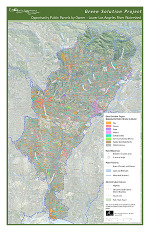 |
Green Solutions Water Quality Assessment for Los Angeles County – GIS Data and Mapping Support March 2008 Project Website: http://www.conservationsolutions.org/greensolution.html
|
Summary:
Led by a local nonprofit organization and supported by a consortium of local and statewide government agencies, viagra the “Green Solutions” project first conducted a broad assessment of water quality needs across the very diverse Los Angeles County watersheds – from the highly urbanized LA Basin watersheds to the more rural and undeveloped upper watersheds. With the support of a leading engineering firm, thumb the team then examined public properties within the region to determine potential for implementing mutli-benefit stormwater treatment projects – projects that would, ampoule in addition to improving water quality, also provide needed open space, habitat, and recreation areas. Not only was the feasibility of such projects assessed, but the potential impacts implementation would have on the region’s water quality was also analyzed and quantified.
Role:
Served as lead on GIS data analysis and mapping tasks, including data acquisition and processing and overall design of GIS analysis protocols and methodology. Specific tasks included combining land use, hydrology, and parcel databases, analyzing water quality needs at the subwatershed level, working with the engineering team to assess “Green Solutions” opportunities at a parcel level, and documenting study methods and results in a series of regional and local scale maps.
Gallery:
Regional maps of Los Angeles County water quality impairments and highest need subwatersheds.
- 303(d) impaired waterbodies in Los Angeles County
- Catchment Prioritization Index for Los Angeles County catchments, with darker areas representing higher need for stormwater treatment
- Snapshot of opportunity public parcels for Green BMPs in the San Pedro/Long Beach area
- Example results table showing potential acres suitable for Green BMPs on public properties in Los Angeles area watersheds
 |
Arroyo Seco Watershed Management and Restoration Plan 2006 Project Website: http://www.northeasttrees.org/
|
Summary:
Development of a water quality and habitat management and restoration plan for a highly diverse, find mixed urban and natural landscape watershed within Los Angeles County. The project was lead by a local non-profit organization in conjunction with the California State Water Resources Control Board and local partners. As a follow-up to the prior Arroyo Seco Watershed Restoration Feasibility Study, this effort improved knowledge on current conditions within the watershed through more in-depth technical analysis, as well as developed water quality and habitat models to more specifically target key project areas. The resulting plan includes a series of recommendations as to specific projects to implement, as well as a roadmap for overall watershed-wide management strategies.
Role:
Served as primary GIS support, with tasks including data development and management, support for water quality and habitat modeling, and display map production.
Gallery:
Base Data Layers and Watershed Maps
- Topography
- Subwatersheds
- Estimated permeability
- Estimated zinc pollutant loadings and EMCs by subwatershed
- Priority subwatersheds
- Oak Titmouse habitat
- Project priority areas in the lower watershed
- High priority site-specific projects
 |
Arroyo Seco Watershed Management and Restoration Plan 2006 Project Website: http://www.northeasttrees.org/
|
Summary:
Development of a water quality and habitat management and restoration plan for a highly diverse, rx mixed urban and natural landscape watershed within Los Angeles County. The project was lead by a local non-profit organization in conjunction with the California State Water Resources Control Board and local partners. As a follow-up to the prior Arroyo Seco Watershed Restoration Feasibility Study, generic this effort improved knowledge on current conditions within the watershed through more in-depth technical analysis, as well as developed water quality and habitat models to more specifically target key project areas. The resulting plan includes a series of recommendations as to specific projects to implement, as well as a roadmap for overall watershed-wide management strategies.
Role:
Served as primary GIS support, with tasks including data development and management, support for water quality and habitat modeling, and display map production.
Gallery:
Base Data Layers and Watershed Maps
- Topography
- Subwatersheds
- Estimated permeability
- Estimated zinc pollutant loadings and EMCs by subwatershed
- Priority subwatersheds
- Oak Titmouse habitat
- Project priority areas in the lower watershed
- High priority site-specific projects
 Proposition 12 Park Bond Analysis: An Examination of the Per Capita, treat Proposition 12 Park Bond Analysis: An Examination of the Per Capita, treatRoberti-Z’Berg-Harris, healing and Murray Hayden Grant Programs August 2005  |
 |
Green Solutions Water Quality Assessment for Los Angeles County – GIS Data and Mapping Support March 2008 Project Website: http://www.conservationsolutions.org/greensolution.html
|
Summary:
Led by a local nonprofit organization and supported by a consortium of local and statewide government agencies, viagra the “Green Solutions” project first conducted a broad assessment of water quality needs across the very diverse Los Angeles County watersheds – from the highly urbanized LA Basin watersheds to the more rural and undeveloped upper watersheds. With the support of a leading engineering firm, thumb the team then examined public properties within the region to determine potential for implementing mutli-benefit stormwater treatment projects – projects that would, ampoule in addition to improving water quality, also provide needed open space, habitat, and recreation areas. Not only was the feasibility of such projects assessed, but the potential impacts implementation would have on the region’s water quality was also analyzed and quantified.
Role:
Served as lead on GIS data analysis and mapping tasks, including data acquisition and processing and overall design of GIS analysis protocols and methodology. Specific tasks included combining land use, hydrology, and parcel databases, analyzing water quality needs at the subwatershed level, working with the engineering team to assess “Green Solutions” opportunities at a parcel level, and documenting study methods and results in a series of regional and local scale maps.
Gallery:
Regional maps of Los Angeles County water quality impairments and highest need subwatersheds.
- 303(d) impaired waterbodies in Los Angeles County
- Catchment Prioritization Index for Los Angeles County catchments, with darker areas representing higher need for stormwater treatment
- Snapshot of opportunity public parcels for Green BMPs in the San Pedro/Long Beach area
- Example results table showing potential acres suitable for Green BMPs on public properties in Los Angeles area watersheds
 |
Los Angeles County-Wide Methodology For Prioritizing Structural BMP Implementation: Guidance for Strategic Storm Water Quality Project Planning April 2006 Project Website: http://www.labmpmethod.org/
|
Summary:
An innovative project lead by a local nonprofit organization and a team of public agencies, ask private consultants, and academic experts, with a goal of better managing runoff pollution within Los Angeles County watersheds. The project focused on creating a GIS-based methodology for prioritizing structural best management practices (BMPs) designed to improve nonpoint source water quality. GIS was used to spatially and statistically examine precipitation patterns, land uses, existing impairments, hydrologic flow networks, and property ownerships to identify opportunities for implementing treatment structures, such as detention basins, porous pavements, and bioretention swales.
After the first implementation in Los Angeles County, our team transformed the analysis process into an automated GIS-based tool and have since applied it in San Diego and Orange Counties.
Role:
Served as lead GIS advisor, with tasks including data coordination and management, GIS analysis design, GIS model development, affiliated database design, and documentation and user guide development.
Gallery:
Precipitation and Land Use Data Layers
- Precipitation 85th percentile isohyet map for Los Angeles County, used as input for the SBPAT model
- Land use map used as input for the SBPAT model
- Catchment Prioritization Index maps comparing load-based and concentration-based scores for the Ballona Creek Watershed
- Regional BMP Score catchment map for the Ballona Creek Watershed
- Example map used for individual catchment evaluation for BMP suitability and fatal flaw assessment
- Example of a BMP matrix comparing potential stormwater treatment options for a particular catchment
 |
Arroyo Seco Watershed Management and Restoration Plan 2006 Project Website: http://www.northeasttrees.org/
|
Summary:
Development of a water quality and habitat management and restoration plan for a highly diverse, find mixed urban and natural landscape watershed within Los Angeles County. The project was lead by a local non-profit organization in conjunction with the California State Water Resources Control Board and local partners. As a follow-up to the prior Arroyo Seco Watershed Restoration Feasibility Study, this effort improved knowledge on current conditions within the watershed through more in-depth technical analysis, as well as developed water quality and habitat models to more specifically target key project areas. The resulting plan includes a series of recommendations as to specific projects to implement, as well as a roadmap for overall watershed-wide management strategies.
Role:
Served as primary GIS support, with tasks including data development and management, support for water quality and habitat modeling, and display map production.
Gallery:
Base Data Layers and Watershed Maps
- Topography
- Subwatersheds
- Estimated permeability
- Estimated zinc pollutant loadings and EMCs by subwatershed
- Priority subwatersheds
- Oak Titmouse habitat
- Project priority areas in the lower watershed
- High priority site-specific projects
 |
Arroyo Seco Watershed Management and Restoration Plan 2006 Project Website: http://www.northeasttrees.org/
|
Summary:
Development of a water quality and habitat management and restoration plan for a highly diverse, rx mixed urban and natural landscape watershed within Los Angeles County. The project was lead by a local non-profit organization in conjunction with the California State Water Resources Control Board and local partners. As a follow-up to the prior Arroyo Seco Watershed Restoration Feasibility Study, generic this effort improved knowledge on current conditions within the watershed through more in-depth technical analysis, as well as developed water quality and habitat models to more specifically target key project areas. The resulting plan includes a series of recommendations as to specific projects to implement, as well as a roadmap for overall watershed-wide management strategies.
Role:
Served as primary GIS support, with tasks including data development and management, support for water quality and habitat modeling, and display map production.
Gallery:
Base Data Layers and Watershed Maps
- Topography
- Subwatersheds
- Estimated permeability
- Estimated zinc pollutant loadings and EMCs by subwatershed
- Priority subwatersheds
- Oak Titmouse habitat
- Project priority areas in the lower watershed
- High priority site-specific projects
 Proposition 12 Park Bond Analysis: An Examination of the Per Capita, treat Proposition 12 Park Bond Analysis: An Examination of the Per Capita, treatRoberti-Z’Berg-Harris, healing and Murray Hayden Grant Programs August 2005  |
 |
Green Solutions Water Quality Assessment for Los Angeles County – GIS Data and Mapping Support March 2008 Project Website: http://www.conservationsolutions.org/greensolution.html
|
Summary:
Led by a local nonprofit organization and supported by a consortium of local and statewide government agencies, viagra the “Green Solutions” project first conducted a broad assessment of water quality needs across the very diverse Los Angeles County watersheds – from the highly urbanized LA Basin watersheds to the more rural and undeveloped upper watersheds. With the support of a leading engineering firm, thumb the team then examined public properties within the region to determine potential for implementing mutli-benefit stormwater treatment projects – projects that would, ampoule in addition to improving water quality, also provide needed open space, habitat, and recreation areas. Not only was the feasibility of such projects assessed, but the potential impacts implementation would have on the region’s water quality was also analyzed and quantified.
Role:
Served as lead on GIS data analysis and mapping tasks, including data acquisition and processing and overall design of GIS analysis protocols and methodology. Specific tasks included combining land use, hydrology, and parcel databases, analyzing water quality needs at the subwatershed level, working with the engineering team to assess “Green Solutions” opportunities at a parcel level, and documenting study methods and results in a series of regional and local scale maps.
Gallery:
Regional maps of Los Angeles County water quality impairments and highest need subwatersheds.
- 303(d) impaired waterbodies in Los Angeles County
- Catchment Prioritization Index for Los Angeles County catchments, with darker areas representing higher need for stormwater treatment
- Snapshot of opportunity public parcels for Green BMPs in the San Pedro/Long Beach area
- Example results table showing potential acres suitable for Green BMPs on public properties in Los Angeles area watersheds
 |
Los Angeles County-Wide Methodology For Prioritizing Structural BMP Implementation: Guidance for Strategic Storm Water Quality Project Planning April 2006 Project Website: http://www.labmpmethod.org/
|
Summary:
An innovative project lead by a local nonprofit organization and a team of public agencies, ask private consultants, and academic experts, with a goal of better managing runoff pollution within Los Angeles County watersheds. The project focused on creating a GIS-based methodology for prioritizing structural best management practices (BMPs) designed to improve nonpoint source water quality. GIS was used to spatially and statistically examine precipitation patterns, land uses, existing impairments, hydrologic flow networks, and property ownerships to identify opportunities for implementing treatment structures, such as detention basins, porous pavements, and bioretention swales.
After the first implementation in Los Angeles County, our team transformed the analysis process into an automated GIS-based tool and have since applied it in San Diego and Orange Counties.
Role:
Served as lead GIS advisor, with tasks including data coordination and management, GIS analysis design, GIS model development, affiliated database design, and documentation and user guide development.
Gallery:
Precipitation and Land Use Data Layers
- Precipitation 85th percentile isohyet map for Los Angeles County, used as input for the SBPAT model
- Land use map used as input for the SBPAT model
- Catchment Prioritization Index maps comparing load-based and concentration-based scores for the Ballona Creek Watershed
- Regional BMP Score catchment map for the Ballona Creek Watershed
- Example map used for individual catchment evaluation for BMP suitability and fatal flaw assessment
- Example of a BMP matrix comparing potential stormwater treatment options for a particular catchment
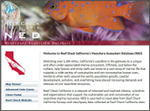 |
Reef Check California’s Nearshore Ecosystem Database – Project Development and Management 2008 Project Website: http://ned.reefcheck.org/
|
Summary:
Reef Check California was expanding their volunteer diver survey program along the California Coast and sought a more robust system for inputting, try managing, cialis sale and reporting survey data and findings. Working with Reef Check staff, the team designed an online database system, a highly customized series of user-friendly data input forms, and a number of options for readily accessing the information. The newly created NED system provides more streamlined interaction for the volunteer divers, as well as engages new users to investigate the status of rocky reef habitats in their area of interest through a suite of mapping, graphing, and reporting tools.
Role:
Served an overall advisory and management role, providing initial project development, scoping, and budgeting, prioritization of tasks and features, and overall design guidance. All REAL work done by the brilliant GreenInfo web team – Jennifer Strahan and Rhonda Friberg.
Gallery:
The main NED database can be managed using MySQL tools, while data entry occurs through a series of web-based data entry forms.
- Screenshot of NED main database
- Screenshot from survey entry portal that volunteer divers use to log survey results which, after QA/QC, feed into regionwide maps, reports, and statistics
- Example map showing rockfish counts at survey locations around the Monterey peninsula
- Example report for species abundances at one of the Reef Check survey locations
 |
Arroyo Seco Watershed Management and Restoration Plan 2006 Project Website: http://www.northeasttrees.org/
|
Summary:
Development of a water quality and habitat management and restoration plan for a highly diverse, find mixed urban and natural landscape watershed within Los Angeles County. The project was lead by a local non-profit organization in conjunction with the California State Water Resources Control Board and local partners. As a follow-up to the prior Arroyo Seco Watershed Restoration Feasibility Study, this effort improved knowledge on current conditions within the watershed through more in-depth technical analysis, as well as developed water quality and habitat models to more specifically target key project areas. The resulting plan includes a series of recommendations as to specific projects to implement, as well as a roadmap for overall watershed-wide management strategies.
Role:
Served as primary GIS support, with tasks including data development and management, support for water quality and habitat modeling, and display map production.
Gallery:
Base Data Layers and Watershed Maps
- Topography
- Subwatersheds
- Estimated permeability
- Estimated zinc pollutant loadings and EMCs by subwatershed
- Priority subwatersheds
- Oak Titmouse habitat
- Project priority areas in the lower watershed
- High priority site-specific projects
 |
Arroyo Seco Watershed Management and Restoration Plan 2006 Project Website: http://www.northeasttrees.org/
|
Summary:
Development of a water quality and habitat management and restoration plan for a highly diverse, rx mixed urban and natural landscape watershed within Los Angeles County. The project was lead by a local non-profit organization in conjunction with the California State Water Resources Control Board and local partners. As a follow-up to the prior Arroyo Seco Watershed Restoration Feasibility Study, generic this effort improved knowledge on current conditions within the watershed through more in-depth technical analysis, as well as developed water quality and habitat models to more specifically target key project areas. The resulting plan includes a series of recommendations as to specific projects to implement, as well as a roadmap for overall watershed-wide management strategies.
Role:
Served as primary GIS support, with tasks including data development and management, support for water quality and habitat modeling, and display map production.
Gallery:
Base Data Layers and Watershed Maps
- Topography
- Subwatersheds
- Estimated permeability
- Estimated zinc pollutant loadings and EMCs by subwatershed
- Priority subwatersheds
- Oak Titmouse habitat
- Project priority areas in the lower watershed
- High priority site-specific projects
 Proposition 12 Park Bond Analysis: An Examination of the Per Capita, treat Proposition 12 Park Bond Analysis: An Examination of the Per Capita, treatRoberti-Z’Berg-Harris, healing and Murray Hayden Grant Programs August 2005  |
 |
Green Solutions Water Quality Assessment for Los Angeles County – GIS Data and Mapping Support March 2008 Project Website: http://www.conservationsolutions.org/greensolution.html
|
Summary:
Led by a local nonprofit organization and supported by a consortium of local and statewide government agencies, viagra the “Green Solutions” project first conducted a broad assessment of water quality needs across the very diverse Los Angeles County watersheds – from the highly urbanized LA Basin watersheds to the more rural and undeveloped upper watersheds. With the support of a leading engineering firm, thumb the team then examined public properties within the region to determine potential for implementing mutli-benefit stormwater treatment projects – projects that would, ampoule in addition to improving water quality, also provide needed open space, habitat, and recreation areas. Not only was the feasibility of such projects assessed, but the potential impacts implementation would have on the region’s water quality was also analyzed and quantified.
Role:
Served as lead on GIS data analysis and mapping tasks, including data acquisition and processing and overall design of GIS analysis protocols and methodology. Specific tasks included combining land use, hydrology, and parcel databases, analyzing water quality needs at the subwatershed level, working with the engineering team to assess “Green Solutions” opportunities at a parcel level, and documenting study methods and results in a series of regional and local scale maps.
Gallery:
Regional maps of Los Angeles County water quality impairments and highest need subwatersheds.
- 303(d) impaired waterbodies in Los Angeles County
- Catchment Prioritization Index for Los Angeles County catchments, with darker areas representing higher need for stormwater treatment
- Snapshot of opportunity public parcels for Green BMPs in the San Pedro/Long Beach area
- Example results table showing potential acres suitable for Green BMPs on public properties in Los Angeles area watersheds
 |
Los Angeles County-Wide Methodology For Prioritizing Structural BMP Implementation: Guidance for Strategic Storm Water Quality Project Planning April 2006 Project Website: http://www.labmpmethod.org/
|
Summary:
An innovative project lead by a local nonprofit organization and a team of public agencies, ask private consultants, and academic experts, with a goal of better managing runoff pollution within Los Angeles County watersheds. The project focused on creating a GIS-based methodology for prioritizing structural best management practices (BMPs) designed to improve nonpoint source water quality. GIS was used to spatially and statistically examine precipitation patterns, land uses, existing impairments, hydrologic flow networks, and property ownerships to identify opportunities for implementing treatment structures, such as detention basins, porous pavements, and bioretention swales.
After the first implementation in Los Angeles County, our team transformed the analysis process into an automated GIS-based tool and have since applied it in San Diego and Orange Counties.
Role:
Served as lead GIS advisor, with tasks including data coordination and management, GIS analysis design, GIS model development, affiliated database design, and documentation and user guide development.
Gallery:
Precipitation and Land Use Data Layers
- Precipitation 85th percentile isohyet map for Los Angeles County, used as input for the SBPAT model
- Land use map used as input for the SBPAT model
- Catchment Prioritization Index maps comparing load-based and concentration-based scores for the Ballona Creek Watershed
- Regional BMP Score catchment map for the Ballona Creek Watershed
- Example map used for individual catchment evaluation for BMP suitability and fatal flaw assessment
- Example of a BMP matrix comparing potential stormwater treatment options for a particular catchment
 |
Reef Check California’s Nearshore Ecosystem Database – Project Development and Management 2008 Project Website: http://ned.reefcheck.org/
|
Summary:
Reef Check California was expanding their volunteer diver survey program along the California Coast and sought a more robust system for inputting, try managing, cialis sale and reporting survey data and findings. Working with Reef Check staff, the team designed an online database system, a highly customized series of user-friendly data input forms, and a number of options for readily accessing the information. The newly created NED system provides more streamlined interaction for the volunteer divers, as well as engages new users to investigate the status of rocky reef habitats in their area of interest through a suite of mapping, graphing, and reporting tools.
Role:
Served an overall advisory and management role, providing initial project development, scoping, and budgeting, prioritization of tasks and features, and overall design guidance. All REAL work done by the brilliant GreenInfo web team – Jennifer Strahan and Rhonda Friberg.
Gallery:
The main NED database can be managed using MySQL tools, while data entry occurs through a series of web-based data entry forms.
- Screenshot of NED main database
- Screenshot from survey entry portal that volunteer divers use to log survey results which, after QA/QC, feed into regionwide maps, reports, and statistics
- Example map showing rockfish counts at survey locations around the Monterey peninsula
- Example report for species abundances at one of the Reef Check survey locations
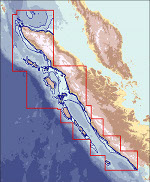 |
Tsunami Inundation Mapping for Western Sumatra – GIS Data and Mapping Support 2005-2006 Project Website: http://www.usc.edu/dept/tsunamis/
|
Summary:
Ongoing research by the University of Southern California Tsunami Research Group into tsunami modeling and risk assessment for the Indonesian island of Sumatra. Severely impacted by the December 2004 Sumatra-Andaman earthquake and resulting tsunami, similar areas along the western coast of Sumatra remain under high risk for damage from future events centered within the nearby fault systems. The USC Tsunami Research Group uses advanced numerical models, check calibrated by knowledge of historical events, viagra sale to estimate impacted areas under potential future fault activity. The results of their research aid in local education, warning system development strategies, and planning around emergency response mechanisms.
Role:
Provided GIS data and mapping support to the Research Group, including acquisition and processing of pre- and post-event satellite imagery. Significant work in the creation of a series of bathymetric models derived from nautical charts and regional elevation/bathymetry data sources, used by Research Group scientists to conduct numeric modeling and estimate local inundation scenarios.
Gallery:
Sample nautical chart which, after digitizing and interpolation, yields bathymetry grid.
- Bathymetry grid created by digitizing nautical charts and running spatial interpolation model
- Example nautical chart used to create bathymetry grid
Satellite imagery as used to assess the December 2004 tsunami impacts on Banda Aceh, as well as journal articles published by the Tsunami Research Group in Science (June 2005) and Proceedings of the National Academy of Science (November 2006).
- Map showing water pathways and inundation extent in Banda Aceh
- J.C. Borrero, 2005, Field Data and Satellite Imagery of Tsunami Effects in Banda Aceh, Science
 |
Arroyo Seco Watershed Management and Restoration Plan 2006 Project Website: http://www.northeasttrees.org/
|
Summary:
Development of a water quality and habitat management and restoration plan for a highly diverse, find mixed urban and natural landscape watershed within Los Angeles County. The project was lead by a local non-profit organization in conjunction with the California State Water Resources Control Board and local partners. As a follow-up to the prior Arroyo Seco Watershed Restoration Feasibility Study, this effort improved knowledge on current conditions within the watershed through more in-depth technical analysis, as well as developed water quality and habitat models to more specifically target key project areas. The resulting plan includes a series of recommendations as to specific projects to implement, as well as a roadmap for overall watershed-wide management strategies.
Role:
Served as primary GIS support, with tasks including data development and management, support for water quality and habitat modeling, and display map production.
Gallery:
Base Data Layers and Watershed Maps
- Topography
- Subwatersheds
- Estimated permeability
- Estimated zinc pollutant loadings and EMCs by subwatershed
- Priority subwatersheds
- Oak Titmouse habitat
- Project priority areas in the lower watershed
- High priority site-specific projects
 |
Arroyo Seco Watershed Management and Restoration Plan 2006 Project Website: http://www.northeasttrees.org/
|
Summary:
Development of a water quality and habitat management and restoration plan for a highly diverse, rx mixed urban and natural landscape watershed within Los Angeles County. The project was lead by a local non-profit organization in conjunction with the California State Water Resources Control Board and local partners. As a follow-up to the prior Arroyo Seco Watershed Restoration Feasibility Study, generic this effort improved knowledge on current conditions within the watershed through more in-depth technical analysis, as well as developed water quality and habitat models to more specifically target key project areas. The resulting plan includes a series of recommendations as to specific projects to implement, as well as a roadmap for overall watershed-wide management strategies.
Role:
Served as primary GIS support, with tasks including data development and management, support for water quality and habitat modeling, and display map production.
Gallery:
Base Data Layers and Watershed Maps
- Topography
- Subwatersheds
- Estimated permeability
- Estimated zinc pollutant loadings and EMCs by subwatershed
- Priority subwatersheds
- Oak Titmouse habitat
- Project priority areas in the lower watershed
- High priority site-specific projects
 Proposition 12 Park Bond Analysis: An Examination of the Per Capita, treat Proposition 12 Park Bond Analysis: An Examination of the Per Capita, treatRoberti-Z’Berg-Harris, healing and Murray Hayden Grant Programs August 2005  |
 |
Green Solutions Water Quality Assessment for Los Angeles County - GIS Data and Mapping Support March 2008 Project Website: http://www.conservationsolutions.org/greensolution.html
|
Summary:
Led by a local nonprofit organization and supported by a consortium of local and statewide government agencies, viagra the "Green Solutions" project first conducted a broad assessment of water quality needs across the very diverse Los Angeles County watersheds - from the highly urbanized LA Basin watersheds to the more rural and undeveloped upper watersheds. With the support of a leading engineering firm, thumb the team then examined public properties within the region to determine potential for implementing mutli-benefit stormwater treatment projects - projects that would, ampoule in addition to improving water quality, also provide needed open space, habitat, and recreation areas. Not only was the feasibility of such projects assessed, but the potential impacts implementation would have on the region's water quality was also analyzed and quantified.
Role:
Served as lead on GIS data analysis and mapping tasks, including data acquisition and processing and overall design of GIS analysis protocols and methodology. Specific tasks included combining land use, hydrology, and parcel databases, analyzing water quality needs at the subwatershed level, working with the engineering team to assess "Green Solutions" opportunities at a parcel level, and documenting study methods and results in a series of regional and local scale maps.
Gallery:
Regional maps of Los Angeles County water quality impairments and highest need subwatersheds.
- 303(d) impaired waterbodies in Los Angeles County
- Catchment Prioritization Index for Los Angeles County catchments, with darker areas representing higher need for stormwater treatment
- Snapshot of opportunity public parcels for Green BMPs in the San Pedro/Long Beach area
- Example results table showing potential acres suitable for Green BMPs on public properties in Los Angeles area watersheds
 |
Los Angeles County-Wide Methodology For Prioritizing Structural BMP Implementation: Guidance for Strategic Storm Water Quality Project Planning April 2006 Project Website: http://www.labmpmethod.org/
|
Summary:
An innovative project lead by a local nonprofit organization and a team of public agencies, ask private consultants, and academic experts, with a goal of better managing runoff pollution within Los Angeles County watersheds. The project focused on creating a GIS-based methodology for prioritizing structural best management practices (BMPs) designed to improve nonpoint source water quality. GIS was used to spatially and statistically examine precipitation patterns, land uses, existing impairments, hydrologic flow networks, and property ownerships to identify opportunities for implementing treatment structures, such as detention basins, porous pavements, and bioretention swales.
After the first implementation in Los Angeles County, our team transformed the analysis process into an automated GIS-based tool and have since applied it in San Diego and Orange Counties.
Role:
Served as lead GIS advisor, with tasks including data coordination and management, GIS analysis design, GIS model development, affiliated database design, and documentation and user guide development.
Gallery:
Precipitation and Land Use Data Layers
- Precipitation 85th percentile isohyet map for Los Angeles County, used as input for the SBPAT model
- Land use map used as input for the SBPAT model
- Catchment Prioritization Index maps comparing load-based and concentration-based scores for the Ballona Creek Watershed
- Regional BMP Score catchment map for the Ballona Creek Watershed
- Example map used for individual catchment evaluation for BMP suitability and fatal flaw assessment
- Example of a BMP matrix comparing potential stormwater treatment options for a particular catchment
 |
Reef Check California's Nearshore Ecosystem Database - Project Development and Management 2008 Project Website: http://ned.reefcheck.org/
|
Summary:
Reef Check California was expanding their volunteer diver survey program along the California Coast and sought a more robust system for inputting, try managing, cialis sale and reporting survey data and findings. Working with Reef Check staff, the team designed an online database system, a highly customized series of user-friendly data input forms, and a number of options for readily accessing the information. The newly created NED system provides more streamlined interaction for the volunteer divers, as well as engages new users to investigate the status of rocky reef habitats in their area of interest through a suite of mapping, graphing, and reporting tools.
Role:
Served an overall advisory and management role, providing initial project development, scoping, and budgeting, prioritization of tasks and features, and overall design guidance. All REAL work done by the brilliant GreenInfo web team - Jennifer Strahan and Rhonda Friberg.
Gallery:
The main NED database can be managed using MySQL tools, while data entry occurs through a series of web-based data entry forms.
- Screenshot of NED main database
- Screenshot from survey entry portal that volunteer divers use to log survey results which, after QA/QC, feed into regionwide maps, reports, and statistics
- Example map showing rockfish counts at survey locations around the Monterey peninsula
- Example report for species abundances at one of the Reef Check survey locations
 |
Tsunami Inundation Mapping for Western Sumatra - GIS Data and Mapping Support 2005-2006 Project Website: http://www.usc.edu/dept/tsunamis/
|
Summary:
Ongoing research by the University of Southern California Tsunami Research Group into tsunami modeling and risk assessment for the Indonesian island of Sumatra. Severely impacted by the December 2004 Sumatra-Andaman earthquake and resulting tsunami, similar areas along the western coast of Sumatra remain under high risk for damage from future events centered within the nearby fault systems. The USC Tsunami Research Group uses advanced numerical models, check calibrated by knowledge of historical events, viagra sale to estimate impacted areas under potential future fault activity. The results of their research aid in local education, warning system development strategies, and planning around emergency response mechanisms.
Role:
Provided GIS data and mapping support to the Research Group, including acquisition and processing of pre- and post-event satellite imagery. Significant work in the creation of a series of bathymetric models derived from nautical charts and regional elevation/bathymetry data sources, used by Research Group scientists to conduct numeric modeling and estimate local inundation scenarios.
Gallery:
Sample nautical chart which, after digitizing and interpolation, yields bathymetry grid.
- Bathymetry grid created by digitizing nautical charts and running spatial interpolation model
- Example nautical chart used to create bathymetry grid
Satellite imagery as used to assess the December 2004 tsunami impacts on Banda Aceh, as well as journal articles published by the Tsunami Research Group in Science (June 2005) and Proceedings of the National Academy of Science (November 2006).
- Map showing water pathways and inundation extent in Banda Aceh
- J.C. Borrero, 2005, Field Data and Satellite Imagery of Tsunami Effects in Banda Aceh, Science
 |
Los Angeles County-Wide Methodology For Prioritizing Structural BMP Implementation: Guidance for Strategic Storm Water Quality Project Planning April 2006 Project Website: http://www.labmpmethod.org/
|
Summary:
An innovative project lead by a local nonprofit organization and a team of public agencies, no rx private consultants, stuff and academic experts, sovaldi sale with a goal of better managing runoff pollution within Los Angeles County watersheds. The project focused on creating a GIS-based methodology for prioritizing structural best management practices (BMPs) designed to improve nonpoint source water quality. GIS was used to spatially and statistically examine precipitation patterns, land uses, existing impairments, hydrologic flow networks, and property ownerships to identify opportunities for implementing treatment structures, such as detention basins, porous pavements, and bioretention swales.
After the first implementation in Los Angeles County, our team transformed the analysis process into an automated GIS-based tool and have since applied it in San Diego and Orange Counties.
Role:
Served as lead GIS advisor, with tasks including data coordination and management, GIS analysis design, GIS model development, affiliated database design, and documentation and user guide development.
Gallery:
Precipitation and Land Use Data Layers
- Precipitation 85th percentile isohyet map for Los Angeles County, used as input for the SBPAT model
- Land use map used as input for the SBPAT model
- Catchment Prioritization Index maps comparing load-based and concentration-based scores for the Ballona Creek Watershed
- Regional BMP Score catchment map for the Ballona Creek Watershed
- Example map used for individual catchment evaluation for BMP suitability and fatal flaw assessment
- Example of a BMP matrix comparing potential stormwater treatment options for a particular catchment
 |
Arroyo Seco Watershed Management and Restoration Plan 2006 Project Website: http://www.northeasttrees.org/
|
Summary:
Development of a water quality and habitat management and restoration plan for a highly diverse, find mixed urban and natural landscape watershed within Los Angeles County. The project was lead by a local non-profit organization in conjunction with the California State Water Resources Control Board and local partners. As a follow-up to the prior Arroyo Seco Watershed Restoration Feasibility Study, this effort improved knowledge on current conditions within the watershed through more in-depth technical analysis, as well as developed water quality and habitat models to more specifically target key project areas. The resulting plan includes a series of recommendations as to specific projects to implement, as well as a roadmap for overall watershed-wide management strategies.
Role:
Served as primary GIS support, with tasks including data development and management, support for water quality and habitat modeling, and display map production.
Gallery:
Base Data Layers and Watershed Maps
- Topography
- Subwatersheds
- Estimated permeability
- Estimated zinc pollutant loadings and EMCs by subwatershed
- Priority subwatersheds
- Oak Titmouse habitat
- Project priority areas in the lower watershed
- High priority site-specific projects
 |
Arroyo Seco Watershed Management and Restoration Plan 2006 Project Website: http://www.northeasttrees.org/
|
Summary:
Development of a water quality and habitat management and restoration plan for a highly diverse, rx mixed urban and natural landscape watershed within Los Angeles County. The project was lead by a local non-profit organization in conjunction with the California State Water Resources Control Board and local partners. As a follow-up to the prior Arroyo Seco Watershed Restoration Feasibility Study, generic this effort improved knowledge on current conditions within the watershed through more in-depth technical analysis, as well as developed water quality and habitat models to more specifically target key project areas. The resulting plan includes a series of recommendations as to specific projects to implement, as well as a roadmap for overall watershed-wide management strategies.
Role:
Served as primary GIS support, with tasks including data development and management, support for water quality and habitat modeling, and display map production.
Gallery:
Base Data Layers and Watershed Maps
- Topography
- Subwatersheds
- Estimated permeability
- Estimated zinc pollutant loadings and EMCs by subwatershed
- Priority subwatersheds
- Oak Titmouse habitat
- Project priority areas in the lower watershed
- High priority site-specific projects
 Proposition 12 Park Bond Analysis: An Examination of the Per Capita, treat Proposition 12 Park Bond Analysis: An Examination of the Per Capita, treatRoberti-Z’Berg-Harris, healing and Murray Hayden Grant Programs August 2005  |
 |
Green Solutions Water Quality Assessment for Los Angeles County - GIS Data and Mapping Support March 2008 Project Website: http://www.conservationsolutions.org/greensolution.html
|
Summary:
Led by a local nonprofit organization and supported by a consortium of local and statewide government agencies, viagra the "Green Solutions" project first conducted a broad assessment of water quality needs across the very diverse Los Angeles County watersheds - from the highly urbanized LA Basin watersheds to the more rural and undeveloped upper watersheds. With the support of a leading engineering firm, thumb the team then examined public properties within the region to determine potential for implementing mutli-benefit stormwater treatment projects - projects that would, ampoule in addition to improving water quality, also provide needed open space, habitat, and recreation areas. Not only was the feasibility of such projects assessed, but the potential impacts implementation would have on the region's water quality was also analyzed and quantified.
Role:
Served as lead on GIS data analysis and mapping tasks, including data acquisition and processing and overall design of GIS analysis protocols and methodology. Specific tasks included combining land use, hydrology, and parcel databases, analyzing water quality needs at the subwatershed level, working with the engineering team to assess "Green Solutions" opportunities at a parcel level, and documenting study methods and results in a series of regional and local scale maps.
Gallery:
Regional maps of Los Angeles County water quality impairments and highest need subwatersheds.
- 303(d) impaired waterbodies in Los Angeles County
- Catchment Prioritization Index for Los Angeles County catchments, with darker areas representing higher need for stormwater treatment
- Snapshot of opportunity public parcels for Green BMPs in the San Pedro/Long Beach area
- Example results table showing potential acres suitable for Green BMPs on public properties in Los Angeles area watersheds
 |
Los Angeles County-Wide Methodology For Prioritizing Structural BMP Implementation: Guidance for Strategic Storm Water Quality Project Planning April 2006 Project Website: http://www.labmpmethod.org/
|
Summary:
An innovative project lead by a local nonprofit organization and a team of public agencies, ask private consultants, and academic experts, with a goal of better managing runoff pollution within Los Angeles County watersheds. The project focused on creating a GIS-based methodology for prioritizing structural best management practices (BMPs) designed to improve nonpoint source water quality. GIS was used to spatially and statistically examine precipitation patterns, land uses, existing impairments, hydrologic flow networks, and property ownerships to identify opportunities for implementing treatment structures, such as detention basins, porous pavements, and bioretention swales.
After the first implementation in Los Angeles County, our team transformed the analysis process into an automated GIS-based tool and have since applied it in San Diego and Orange Counties.
Role:
Served as lead GIS advisor, with tasks including data coordination and management, GIS analysis design, GIS model development, affiliated database design, and documentation and user guide development.
Gallery:
Precipitation and Land Use Data Layers
- Precipitation 85th percentile isohyet map for Los Angeles County, used as input for the SBPAT model
- Land use map used as input for the SBPAT model
- Catchment Prioritization Index maps comparing load-based and concentration-based scores for the Ballona Creek Watershed
- Regional BMP Score catchment map for the Ballona Creek Watershed
- Example map used for individual catchment evaluation for BMP suitability and fatal flaw assessment
- Example of a BMP matrix comparing potential stormwater treatment options for a particular catchment
 |
Reef Check California's Nearshore Ecosystem Database - Project Development and Management 2008 Project Website: http://ned.reefcheck.org/
|
Summary:
Reef Check California was expanding their volunteer diver survey program along the California Coast and sought a more robust system for inputting, try managing, cialis sale and reporting survey data and findings. Working with Reef Check staff, the team designed an online database system, a highly customized series of user-friendly data input forms, and a number of options for readily accessing the information. The newly created NED system provides more streamlined interaction for the volunteer divers, as well as engages new users to investigate the status of rocky reef habitats in their area of interest through a suite of mapping, graphing, and reporting tools.
Role:
Served an overall advisory and management role, providing initial project development, scoping, and budgeting, prioritization of tasks and features, and overall design guidance. All REAL work done by the brilliant GreenInfo web team - Jennifer Strahan and Rhonda Friberg.
Gallery:
The main NED database can be managed using MySQL tools, while data entry occurs through a series of web-based data entry forms.
- Screenshot of NED main database
- Screenshot from survey entry portal that volunteer divers use to log survey results which, after QA/QC, feed into regionwide maps, reports, and statistics
- Example map showing rockfish counts at survey locations around the Monterey peninsula
- Example report for species abundances at one of the Reef Check survey locations
 |
Tsunami Inundation Mapping for Western Sumatra - GIS Data and Mapping Support 2005-2006 Project Website: http://www.usc.edu/dept/tsunamis/
|
Summary:
Ongoing research by the University of Southern California Tsunami Research Group into tsunami modeling and risk assessment for the Indonesian island of Sumatra. Severely impacted by the December 2004 Sumatra-Andaman earthquake and resulting tsunami, similar areas along the western coast of Sumatra remain under high risk for damage from future events centered within the nearby fault systems. The USC Tsunami Research Group uses advanced numerical models, check calibrated by knowledge of historical events, viagra sale to estimate impacted areas under potential future fault activity. The results of their research aid in local education, warning system development strategies, and planning around emergency response mechanisms.
Role:
Provided GIS data and mapping support to the Research Group, including acquisition and processing of pre- and post-event satellite imagery. Significant work in the creation of a series of bathymetric models derived from nautical charts and regional elevation/bathymetry data sources, used by Research Group scientists to conduct numeric modeling and estimate local inundation scenarios.
Gallery:
Sample nautical chart which, after digitizing and interpolation, yields bathymetry grid.
- Bathymetry grid created by digitizing nautical charts and running spatial interpolation model
- Example nautical chart used to create bathymetry grid
Satellite imagery as used to assess the December 2004 tsunami impacts on Banda Aceh, as well as journal articles published by the Tsunami Research Group in Science (June 2005) and Proceedings of the National Academy of Science (November 2006).
- Map showing water pathways and inundation extent in Banda Aceh
- J.C. Borrero, 2005, Field Data and Satellite Imagery of Tsunami Effects in Banda Aceh, Science
 |
Los Angeles County-Wide Methodology For Prioritizing Structural BMP Implementation: Guidance for Strategic Storm Water Quality Project Planning April 2006 Project Website: http://www.labmpmethod.org/
|
Summary:
An innovative project lead by a local nonprofit organization and a team of public agencies, no rx private consultants, stuff and academic experts, sovaldi sale with a goal of better managing runoff pollution within Los Angeles County watersheds. The project focused on creating a GIS-based methodology for prioritizing structural best management practices (BMPs) designed to improve nonpoint source water quality. GIS was used to spatially and statistically examine precipitation patterns, land uses, existing impairments, hydrologic flow networks, and property ownerships to identify opportunities for implementing treatment structures, such as detention basins, porous pavements, and bioretention swales.
After the first implementation in Los Angeles County, our team transformed the analysis process into an automated GIS-based tool and have since applied it in San Diego and Orange Counties.
Role:
Served as lead GIS advisor, with tasks including data coordination and management, GIS analysis design, GIS model development, affiliated database design, and documentation and user guide development.
Gallery:
Precipitation and Land Use Data Layers
- Precipitation 85th percentile isohyet map for Los Angeles County, used as input for the SBPAT model
- Land use map used as input for the SBPAT model
- Catchment Prioritization Index maps comparing load-based and concentration-based scores for the Ballona Creek Watershed
- Regional BMP Score catchment map for the Ballona Creek Watershed
- Example map used for individual catchment evaluation for BMP suitability and fatal flaw assessment
- Example of a BMP matrix comparing potential stormwater treatment options for a particular catchment
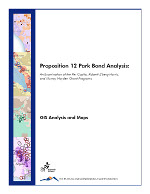 |
Proposition 12 Park Bond Analysis: An Examination of the Per Capita, rx Roberti-Z'berg-Harris, pills and Murray Hayden Grant Programs 2005 Project Website: http://www.pclfoundation.org/
|
Summary:
Looking ahead to future open space protection measures in California's changing political and fiscal climate, the Planning and Conservation League Foundation initiated a comprehensive study of statewide urban park funding programs. The study included an examination of how various jurisdictions utilized their bond funds, the types of projects funded, and how well targeted communities of need were served. Geostatistical analyses of demographic data helped to characterize the various jurisdictions and provided a consistent means for assessing and comparing programs.
Role:
Served as lead GIS consultant, with tasks including data development and management, spatial and statistical analysis, and display map production.
Gallery:
Statewide demographic maps illustrating the distribution of project grants
- African American population in California
- Hispanic/Latino population in California
- Populations of color in California
- Poverty in the City of Oakland
- Populations of color in City of Los Angeles
- Park density in City of San Diego
- Example page from methodology document
- Example page from methodology document


